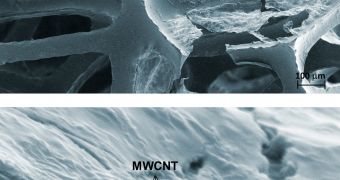A group of investigators based at the US National Institute of Standards and Technology (NIST) announce the development of a new type of coating for furniture upholstery. This innovative material relies on nanoscale structures to decrease flammability by up to 35 percent.
While upholstery may not strike anyone as a vicious killer, official statistics from the United States reveal that fires where upholstery was the first item to burn account for 20 percent of home fire deaths recorded in the country between 2006 and 2010.
The same data indicates that up to 6,700 homes burn every year on account of upholsteries catching fire, leading to roughly 480 human deaths and millions of dollars in property damages. Therefore, reducing the risk of fire could actually contribute to saving many lives annually.
What the NIST team did was basically find a way to create a coating that is completely uniform, even though it is made up of multi-walled carbon nanotubes (MWCNT). This coating can be applied to the foam used in upholsteries and other soft furnishings.
Tests conducted by the research team demonstrated that the flammability of nanotube-coated polyurethane foams was 35 percent lower compared to that of untreated foams. The coating is also able to prevent the melting and pooling of this material, which is a major source of new flames in a fire.
Details of the research effort are published in the January issue of the journal Thin Solid Films. The coating was first proposed by Yeon Seok Kim and Rick Davis, both of whom hold appointments as materials scientists at NIST.
The team explains that the MWCNT were made to cling to the polymers in the foam through the addition of amine groups, which are nitrogen-containing molecules commonly used in genetic studies to make DNA molecules stick more firmly to substrates.
At the center of this coating is the rapid heat-dissipating capability of multi-walled nanotubes, which is what enables foams to face off against flames for longer during fires. The new material is significantly more flame-resistant than the brominated flame retardants used today.
“This kind of technology has the potential to reduce the fire threat associated with burning soft furniture in homes by about a third,” Davis explains.

 14 DAY TRIAL //
14 DAY TRIAL //